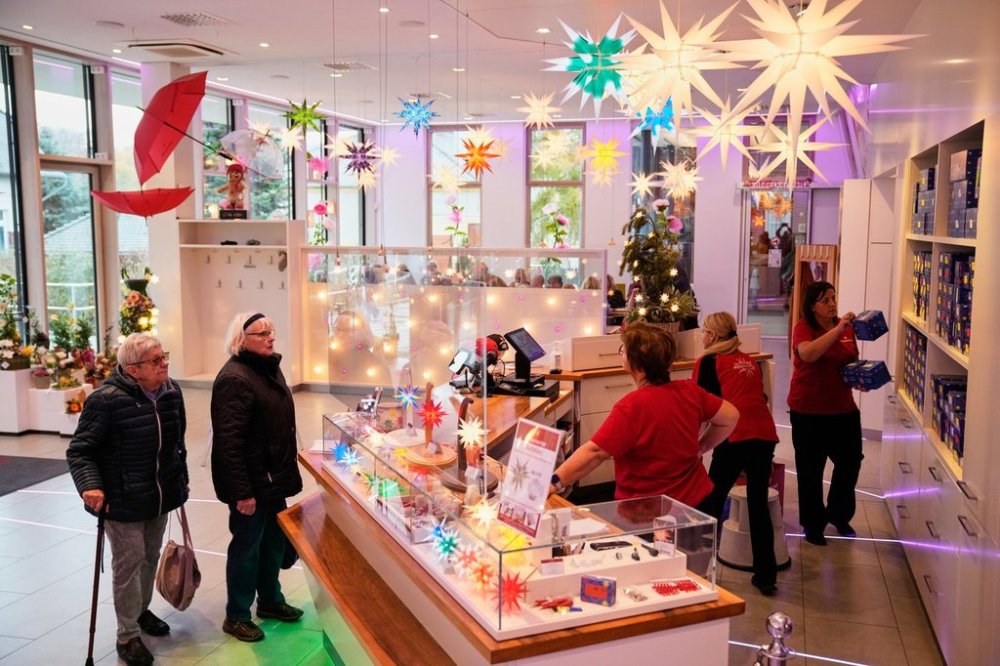Moravian stars light up Germany’s Christmas season
Advertisement
Read this article for free:
or
Already have an account? Log in here »
To continue reading, please subscribe:
Monthly Digital Subscription
$0 for the first 4 weeks*
- Enjoy unlimited reading on winnipegfreepress.com
- Read the E-Edition, our digital replica newspaper
- Access News Break, our award-winning app
- Play interactive puzzles
*No charge for 4 weeks then price increases to the regular rate of $19.00 plus GST every four weeks. Offer available to new and qualified returning subscribers only. Cancel any time.
Monthly Digital Subscription
$4.75/week*
- Enjoy unlimited reading on winnipegfreepress.com
- Read the E-Edition, our digital replica newspaper
- Access News Break, our award-winning app
- Play interactive puzzles
*Billed as $19 plus GST every four weeks. Cancel any time.
To continue reading, please subscribe:
Add Free Press access to your Brandon Sun subscription for only an additional
$1 for the first 4 weeks*
*Your next subscription payment will increase by $1.00 and you will be charged $16.99 plus GST for four weeks. After four weeks, your payment will increase to $23.99 plus GST every four weeks.
Read unlimited articles for free today:
or
Already have an account? Log in here »
HERRNHUT, Germany (AP) — Bright Christmas stars have long been a familiar sight across Germany during the darkest days of the year, but none is more famous — and lately as popular — as the Moravian stars from the eastern village of Herrnhut near the Polish and Czech borders.
They come in different sizes and shine in varying colors. They decorate church steeples and apartment windows, and even adorn the chancellery in Berlin during Advent.
“It’s the symbol of the Star of Bethlehem, which guided the three wise men to the Christ Child in the manger,” said Katja Ruppert, managing director of the Herrnhuter Sterne manufacturing company.

The stars have been handmade for over 180 years in Herrnhut, which was founded by refugees of the Moravian Church fleeing from the historical provinces of Bohemia and Moravia in what is now the Czech Republic.
Members of the church, one of the world’s oldest Protestant denominations, found refuge in the German region in 1722 under the auspices of Count Nikolaus von Zinzendorf, who granted them asylum from prosecution by Catholics. He provided them with land where the believers founded Herrnhut, which roughly translates to “Under the Protection of the Lord.”
The famous Christmas star was created during a geometry lesson
The church members were very active in education. In one of the schools they founded, the famous Moravian star was created when a math teacher — trying to descriptively explain geometry — asked his students to create a “truncated cuboctahedron with 17 four-corner based points and eight three-corner based points.”
That initial cardboard star was patented in 1925, in a way that its points could be dismantled for shipping and later be clamped together again.
The smallest star has a diameter of 8 centimeters (3.14 inches) and sells from 19 euros ($22), while the biggest one measures 130 centimeters and costs 205 euros. Special orders are more expensive and can measure up to 250 cm.
Originally, the points of the Moravian star were white and red, symbolizing both “purity and the blood of Jesus Christ,” Ruppert explained in an interview with The Associated Press.
As the production of the stars expanded, so did the range of colors. Today they are made out of paper or plastic and come monochrome, varicolored, or with patterns including some made out of the pages of old books that are dubbed “literary stars.”
There are even stars with floral spring motives for those who want to keep the decorative ornaments up in their homes all year, not just during Christmas season.
People can make their own stars at a workshop in Herrnhut
Recently, the company also opened a handicrafts workshop in Herrnhut where people can make their own stars. In addition, there’s a big showroom presenting and selling all different varieties. White, yellow and red are among the most popular creations, but the company’s annual special edition — this year its a shiny, purple star — has also become a sought-after collectible item.
“We are now taking part in many Christmas markets. We have gone to trade fairs. We have found many retailers who would like to work with us there,” Ruppert said, explaining how the Moravian star’s popularity has spread widely within Germany in the past 20 years.
Nowadays, about 230 employees make more than 820,000 stars every year and more than 60,000 people visit the store and workshop annually, mostly during the weeks before Christmas.
So far, the star is not being exported extensively to other countries, Ruppert said. But other communities of the Moravian Church such as the one in Bethlehem, Pennsylvania, or Christiansfeld in Denmark, also are featuring the star as a symbol of their faith during Advent.
Silk Schmidt, a hairdresser from Neueibau in southeastern Saxony, had come to Herrnhut with her sister-in-law in mid-November to make three stars as Christmas gifts for her two sons and mother.
“I myself have at least ten stars at home,” she said, adding that she usually puts them up on the first weekend of Advent.
“When it’s so dark outside and not nice anymore, then the stars hang in the window, which is actually really beautiful,” she said.
“Lights everywhere.”
___
Associated Press religion coverage receives support through the AP’s collaboration with The Conversation US, with funding from Lilly Endowment Inc. The AP is solely responsible for this content.
The Free Press acknowledges the financial support it receives from members of the city’s faith community, which makes our coverage of religion possible.

